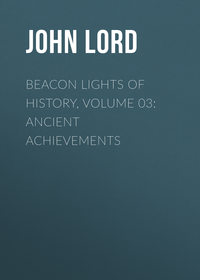 полная версия
полная версияBeacon Lights of History, Volume 14: The New Era
To tell the story of the further excavations is unnecessary. It is all given in Layard's two splendid volumes, "Nineveh and its Remains," and "Babylon and Nineveh;" and the bas-reliefs, statues, bronzes, ivories, and inscriptions are magnificently reproduced in great folio volumes. From Nimroud he went back to Mosul, and there opened the two mounds opposite of Kuyunjik and Neby-Yunus, the site of old Nineveh. There more palaces and friezes were found of other kings. Then he went back to London, closing his successful campaign, more profitable if not more glorious than those of war, and published the story of his work. Its effect was marvellous. No such popular book of travels had ever appeared; for it was a story of adventure, and also of strange discovery. Mr. Layard had not suspected that he had the literary gift, but he had it in rare measure. He had gained an inner view of the heart of tribes, Moslem and Christian and semi-pagan, by his sympathy with them and his knowledge of their tongues. He had lived in their tents and huts. He had saved them from persecution by Turkish governors. Their gratitude to him was beyond words, and he told their story with affection and enthusiasm. Then his discoveries were in the lands made historic not only by the campaigns of Xenophon and Alexander, but made almost sacred by the Bible history. These were the lands whence came the armies that fought with Israel. These were the kings whose wars are told in the Jewish records; and the annals of these kings were found in their palaces, and they gave full accounts of wars of which the Bible had given the outline. Piety and learning joined to give extraordinary interest to these discoveries and to this report of them. Mr. Layard found himself famous, and the monuments he was bringing to the British Museum were, and still are, the most extraordinary and fascinating in all its corridors.
Of course, a new grant was made in behalf of the British Museum, and of course he went back to continue and extend his researches. Now he wished to go further south, beyond Nimroud to Kalah Shergat, the yet earlier capital of Assyria; and yet further to Babylon, that he might see and test the multitude of mounds of ancient Chaldea, the real land of Nimrod, the seat of Eden, and the Tower of Babel, far more ancient than any one of the three capitals of Assyria. While he did scarce more than to visit and report on the Babylonian mounds, his diggings in Nineveh itself were of vast importance, for there he found the library of Asshurbanabal, on clay tablets, which has given us our chief knowledge of the literature and learning of the ancient East. In 1852 he returned to England to publish his "Monuments of Nineveh," and left the further exploration to his able lieutenant, Mr. Rassam, and to a noble succession of explorers who should follow, and to a no less noble line of scholars who should interpret the inscriptions and recover the history of the nations; so that we now know more exactly the history of Babylonian and Assyrian kings, and from more authentic records, and more completely the social condition and business life of the countries, than we do the history of Greece, or the life of the Greeks even of the time of Pericles, and that, too, for a period of three thousand years.
To illustrate this fact, let us take the black obelisk of Shalmaneser II., found by Layard at Nimroud. It is a column of basalt seven feet high and about two feet wide at the base, from which it narrows slightly, until near the top it is reduced by three steps. On the four sides is engraved in five rows of bas-reliefs, twenty in all, the pictured history of the royal conquests, the submission of kings, and the presentation of tribute. Above and below, and between, in two hundred and ten lines, was cut an inscription which explained the figures, and gave a full historical and, of course, contemporary and official account of the glorious events of the royal reign. Not a line was defaced; at the British Museum it can be seen to-day as perfect as when engraved twenty-seven centuries ago. Other monuments of Shalmaneser have been found. One is a great monolith with a portrait of the king in all his fine array, and with one hundred and fifty-six lines of text. Another is a series of splendid bronze plates that covered great wooden gates, on which, in repoussé work, were pictures of the royal victories, and inscriptions explaining them. The Bible tells us of the rivalries and jealousies of Ahab and Jehu, kings of Israel, and Benhadad and Hazael, kings of Damascus. How surprising it is to find here not only the story of the successive campaigns of Shalmaneser against these same kings, the number of their chariots and soldiers, but to see pictured before us the tribute sent by Jehu. We learn that Shalmaneser reigned from 859 to 825 B.C., and we have the record of all his successive campaigns, the first twenty-six of which he led in person. There is not another country of which, before the invention of printing, we have so minute a history; and all had been lost, except the mention of a name or two, whether historical or legendary we hardly knew, until Layard and his fellow-explorers opened the mounds of Assyria.
But enough for Layard. He is only one, though the principal one, of all the explorers of the buried records of the empires of the Tigris and Euphrates. And Babylonia and Assyria are not the only countries that history required us to explore. Greece and its neighboring states and islands have not even yet been fairly investigated. Much of Asia Minor is still a virgin field. Syria and Palestine have hardly been scratched with the spade. More has been done in Egypt, but more yet is to be done. And when we go into the further east of Persia and Old Elam, not to speak of the yet farther east of Central Asia, now just beginning to yield strange treasures to daring travellers, and ancient India and China,–how ancient we know not at all,–there is field for centuries of further research. For we must go back past empires and kingdoms and tribal conditions to the very beginning of the human race on the earth, even if so it be, to the first Pithecanthropus which men of science tell us was the link which connected Homo sapiens with the race of primitive simians. And all this, it may well be, is preserved in undecaying records just a few feet under the ground, if one only knew where to dig for it; nay, we now know where to dig for the most and best of it, and we only await the Stratford Cannings, who will give the money, and the Austen Layards, who have the enthusiasm for the work.
After Layard and Rassam, after Rawlinson and Botta, George Smith took flying trips to the site of Nineveh twice that he might gather the remaining fragments of the great library of Asshurbanabal, and he died in the field far from home. It was he that found among Layard's tablets the Babylonian account of the Deluge, so much like that in the Bible. He was the first of a second generation who, following Rawlinson and Oppert, decipherers as well as explorers, were able to read as they found. I can only mention the names of the Englishmen Taylor and Loftus; of the Frenchmen, Place and De Sarzec; and, later, the Americans, Peters, Hilprecht, and Haynes, who have so faithfully explored the extremely archaic mound of Niffer, which I had the honor to recommend for excavation after I had visited the mounds of Southern Babylonia in the winter of 1884-85. And now the Germans, with scientific as well as commercial and political purpose, with their railroad to pass down the valley through Baghdad to the Persian Gulf, which gives them predominant influence, have sent expeditions well equipped with scholars and engineers to the choicest sites in Babylonia, to Warka, the ancient Erech, and to Babylon itself; and with Teuton thoroughness they are excavating the most famous of ancient ruins and gathering fresh treasures of archaeological research. Nor have they left the land of the Hittites unexplored, for Germany claims the first rights, politically, in all Anatolia, the right of succession and possession when the Turk is expelled, and German archaeological science is bound to be first on that field.
And now what have we found as the fruit of all this labor of exploration? Is it worth the labor and the expense?
Let us look first–it can be only a glance–at Egypt, for Egypt was the land first and most persistently explored. The French Government for scores of years has been at work there. Germans and Italians have explored the ruins; two English societies have for years kept expeditions in the field; and just now a Californian university sends an American Egyptologist to uncover the tombs and read the hieroglyphs of the kings. Not only are the figured monuments of Egypt published in princely folios, but its records have been translated and its lost history recovered to the world's knowledge. Instead of the bare "Pharaoh" of the Bible, a common designation for all the kings, and in place of a bare list of names and dynasties copied from Manetho, and so altered and corrupted in the copying as to be neither Greek nor Egyptian, we have, on scarab, or gravestone, or pyramid, or rock-sepulchre wall, in his own spelling, the name of almost every king from the latest time of the Ptolemies back to the first king of the first dynasty, five thousand–or was it six thousand?–years before Christ. And not their names only, but the very pictures of their wars. We see how they went up the Nile and fought the blacks of Abyssinia, and brought back the spoils of Punt We see them sending their squadrons into Syrian Asia, and waging a dubious battle with the Hittites before the walls of Hamath, where Rameses in his lion-guarded chariot performs prodigies of valor, and from which he returns not only to paint on sacred walls the picture of his victory, but also to inscribe a copy of the treaty of peace with the Hittite king, the earliest treaty in the preserved annals of diplomacy. Well wrought that Rameses the Great for eternal fame in the sixty years of his reign, fifteen centuries before the birth of our Lord. But what fame had been his, had not explorers and excavators and scholars dug and found and copied and translated what the sands had covered for centuries? And to-day the curious traveller stops in sight of the pyramids on the banks of the Nile, and enters the Bulaq Museum, and there he sees set up before him the very mummy of Rameses himself and of a dozen other royal personages, rifled from their tombs and displayed for your amazement and mine. There is the very Pharaoh–you can see his features, you can touch his coffin–who chased the Children of Israel out of Egypt. There are the household implements, the furniture of their homes, the jewelry their queens wore,–queens who were also sisters of the kings, as Sarah was the sister of Abraham.
Or would you know of some great revolution in Egypt? These decipherers of the inscriptions will tell you how the Shepherd Kings overthrew the native dynasty, coming with their armies from Asia long before Rameses, and changed religion and customs; under whom Jacob and his sons found hospitable welcome, until their hated race was expelled by a stronger native dynasty that knew not Joseph. Or they will tell you of the royal reformer Khuenaten, son of a famous Eastern mother, a queen from the banks of the Euphrates. Taught by her, perhaps, a purer religion, he attempted to replace the worship of Egypt's bestial gods by the worship of the one only great God, whose symbol was the sun. But the priestly clan was too strong for him, and the succeeding Pharaohs destroyed his records and chiselled out his name where it had been cut in stone that no memory of his sacrilege might be preserved. A royal Moses there could not be. The worshipper of one God, whether king or son of Pharaoh's daughter, could bring no reformation to Egypt.
Or would you learn how Egypt ruled its subject territory? You can read the correspondence of a dozen local Egyptian governors in Palestine and Syria in the century before Moses led the Hebrew slaves out of Egypt. There is the letter of the King of Jerusalem, where Melchizedek reigned in the times of Abraham; and they tell of rebellions against the fading power of Egypt, and of the fear of the advancing Hittites. The earliest kings, those that built the pyramids, appear before us real in their personality, emerging out of misty legend or myth, and, earlier still, even the prehistoric races that antedated the very beginning of civilization. Whence came that first dynasty? Who invented writing? Were they autochthons? Hardly. These are questions left for further explorers to answer. Probably those first messengers of civilization came from the East, perhaps from Arabia, perhaps from Babylonia, or perhaps the first Babylonians and Egyptians formed a common stock somewhere near the mouth of the Euphrates. Perhaps the Bible is right in saying that the first seat of civilized man was in Eden, and that the Euphrates was the chief river of Paradise. Or was it from Arabia, the immemorial home of the Semitic tribes, that land of sand and mountain and fertile valley, land of changeless culture and tradition, so near the centres of civilization, and yet still the most inaccessible, the least known portion of the inhabited earth,–was it from Arabia that the wiser, stronger multitude came that first overran the valleys of both the Nile and the Euphrates, bringing to Egypt and Chaldea arts and letters? We do not know. Some future explorer must teach us. But the German Glaser has within these few years brought back from hazardous journeys a multitude of inscriptions that tell of kingdoms that fringed its southern coast and extended we know not how far into the interior in those early days when one of the queens of Sheba brought presents to Solomon, and when, earlier still, we are told there were dukes of Edom before there was any king in Israel. They say that a railroad is to be built to Mecca; Arabia is not to be always a closed land, neighbor as it is to Egypt. We shall know one of these days whether, as scholars suspect, out of Arabia and across the Straits of Bab-el-Mandeb, where, at the southern end of the Red Sea, Africa almost touches Asia, there came that mighty flood of more forceful men, bred in the deserts and hills, who, passing down the Nile, first brought history to Egypt; and whether it was this same Semitic people, as scholars suspect again, that spread resistlessly eastward to the Euphrates valley, and did an equal service in conquering and assimilating the black aborigines of these swamps and lagoons. The spade will tell us.
Or was it still further east, in the highlands of Persia, that men first learned how to write and record history? We cannot go back so far in the history of Babylonia–Professor Hilprecht dares to carry us seven thousand years before Christ–that we do not find its kings fighting against Elam. And only in the last decade of the Nineteenth century the Frenchman De Morgan has made marvellous discoveries in the Elamite lands. What a noble passion those Frenchmen have for discovery! For Egypt did not Napoleon provide the most elephantine books of monuments and records that printing-presses have yet issued? And from that time to this have not Frenchmen held the primacy in excavations until, even while England holds and rules Egypt, she leaves, by special convention, the care of its monuments and their exploration to French savants? And before Layard removed a basketful of the earth that covered the palace of Shalmaneser at Nimroud, had not the Frenchman Botta disclosed the friezes and sphinxes of Sargon at Khorsabad; and in these late years is it not the Frenchman De Sarzec who has brought from Telloh to the Louvre the statues of Chaldean kings that lived almost five thousand years ago? And so to France was given the right, for the honor and enrichment of the Louvre, to explore Persia; and De Morgan went to Susa, to Shushan, the palace of Xerxes and Darius, of Ahasuerus and Esther, in search of what was far earlier than they, for another Frenchman and his wife, M. and Mme. Dieulafoy, had already excavated the noble palace of these Persian kings. Far below the palace of Xerxes he has found vastly earlier remains. There is the column set up, if we can believe the Assyriologists who trust the chronology of Nabonidus, the last king of Babylon,–and it is not incredible,–three thousand eight hundred years before Christ, by Naram-Sin, a Babylonian king, to commemorate one of his raids into the land of what were perhaps his stronger enemies. It is a noble composition, with archaic writing, and a stately figure of the king climbing the mountains and slaying his enemies; it shows an art that might well have developed into the best that Greece has produced. But De Morgan has only begun to scratch the surface of the mounds of Elam, and a multitude of scholars believe that out of Elam came the first civilization of Chaldea. We shall find out yet; for the record is in the earth, and only waits the man who will dig it out, and then the man who will read it.
We are tempted to go further east and recall that in India, the land where Alexander made his most distant conquests, a multitude of English scholars have been searching the ruins of old temples for the earliest memorials of the worship of Buddha. Just now they have found his birthplace and precious relics. But that takes us too far afield, and would tempt us to further excursions in Burmah and China. We must come back to Western Asia and the shores of Europe.
As has been indicated, the greatest puzzle of ancient history is that of the Hittite empire, which seems to have ruled all Asia Minor at some uncertain time, and to have extended over Syria and Palestine. No sooner had the greatest Egyptian kings, Thothmes and Rameses, ventured their armies into Asia, perhaps in vengeance on the incursions of Ionian pirates, perhaps in requital of the tyrannies of the hated Shepherd Kings, than they learned of the Hittites on the shores of the Euphrates. Then, a century or two later, a mass of official correspondence sent by the Kings of Palestine and Syria, dug up in Egypt, reports that the Hittites had appeared as invaders from the north and beseeches military aid. But the power of Egypt had waned, and the Hittites were supreme until the Assyrians began and carried on for five centuries the uncertain war which ended in the utter overthrow of the Hittites and all their allies in a great battle at Carchemish. That great mound of Carchemish needs to be thoroughly explored. Already an English expedition has very carelessly just opened the hill and exposed, but not fairly published, some few as fine friezes as are to be found in the Assyrian capitals, with unread Hittite inscriptions, and a fine statue of the Hittite Venus; but much remains to reward the student of Oriental history and art. At Senjirli a German expedition under Von Luschan has done more and better work, handsomely published, but this was a smaller Syrian town, and less was to be expected; and yet here, and near by, were found what was not expected, steles (upright slabs or pillars) with the portraits of kings in high relief, covered over with long inscriptions in Aramaic, the oldest and longest as yet discovered anywhere in that language. It was a magnificent result of very moderate labor,–Hittite friezes, Assyrian and Aramean inscriptions all in one little mound. But for the most part we know the art and writing of the Hittites from what we have found above ground, in their towns and fortresses in the hills, for little digging has been done. At Pterium was a principal sacred capital, and there, on a natural corridor of rock, they carved a procession of gods and kings and soldiers that excites the wonder of scholars. As I write, the announcement comes that Professor Sayce has at last discovered the secret of the Hittite hieroglyphs, and we may hope that very soon it will be possible to read them. But there is vastly more of their records yet to be disinterred.
And there remain the two lands most sacred and beloved in poetry and history,–the land of Israel and the land of Homer. It is amazing that so little search has been made to find out what is hidden under the soil of Palestine. Scholars in plenty have walked over the top of it, and have told all that is on the surface, but almost nothing has been done underground, no such excavations as in Egypt or Assyria. I do not forget that the English Palestine Exploration Fund has followed out, with trenches and tunnels, the walls of Jerusalem, nor that one or two old mounds have been partly explored. But what is this to the great work that needs to be done? There has been found on the surface the Moabite Stone, at the old capital of Dibon, a wonderful record of early kings mentioned in the Bible. And there is the short account in the rock-cut conduit of Siloam, of the success of the workmen in the time of Hezekiah, who, beginning at the two ends, did the fine engineering feat of having their tunnels meet correctly in the solid rock. But when Jerusalem is fully explored, and the northern capitals of Bethel and Tirzah and Samaria, and a hundred other mounds that mark the site of Jewish, Israelite, Philistine, and Amorite cities, we may expect marvellous discoveries that will illumine our Holy Scriptures.
And one region yet remains to be considered, the scattered coasts and islands that owned the Greek speech, and that created the Greek civilization. It is not the Greece of the Parthenon and Pericles that we wish to discover, for that we fairly know; but the arts and the history of those earlier Greeks and Trojans that Homer tells of, the age of Agamemnon and Ulysses, of Helen and Hector and Priam, and of the yet earlier tribes that sailed the Aegean, and settled the Mediterranean islands, and sent their ships to the Egyptian coasts, and sought golden fleeces on the Euxine Sea. All about the coast of Asia Minor they lived, while that Hittite power was ruling the interior; and, intermixed with Phoenician trading-posts, they held the great islands of Crete and Cyprus and the shores of Sicily and Italy. What shall we call them? Were they Dorians, or Heraclidae, Achaeans or Pelasgi? Were they of the same race as the mysterious Etruscans, or shall we name them simply Mycenaeans, as we call the art Mycenaean that ruled the islands and coasts down to the Homeric age, and we know not how many centuries earlier, but certainly as far back as the conquering period of the Eighteenth Egyptian Dynasty of Thothmes? Their soldiers and merchants and their fine vases are pictured on the walls of Egypt, and their pottery has long been studied; but we knew little of them until Dr. Schliemann, the Greek merchant who achieved wealth in the United States, bravely opened the great ruins of Troy, in the full patriotism of his assurance that Homer's story of the Trojan war was history as well as poetry. As he found one burnt and buried city under another,–for many times was Troy destroyed,–and extended his investigations to Tiryns and other ancient cities, one volume of splendid research followed another, until the trader had compelled the unwilling scholar to confess that he must dig for both history and art. To be sure, his interpretations were quite too literal at first, but the whole world of classical scholarship has learned from him the new method of research. Splendid have been the results. If we are not sure which stratum represents the city of Priam, we do learn how the people lived, and how fine was their work in silver and gold, and how slight their knowledge of letters. Dr. Schliemann has now a multitude of imitators. France and Germany and England and the United States each maintain a school of archaeology in Athens, and each conducts careful explorations. Our American School lost to the French, for lack of money at the right time, the chance to explore Delphi, but it has carried on careful explorations at Corinth and other places. How wonderful was the discovery, not long ago, of a shipload of bronze and marble statues wrecked while being transported as spoil of war from Corinth to Rome!
But the most surprising discoveries in the realm of old Greek history and art are those that have been made in these last two or three years in Crete. Crete was a famous centre of ancient Greek legend. Jupiter was born and reared on Mount Ida. From another mountain summit in Crete the gods watched the battle on the plains of Troy. There ruled Minos, who first gave laws to men, and who at his death was sent by the gods to judge the shades as they entered the lower world. There was the famous Labyrinth, and there the Minotaur devoured his annual tale of maidens until he was slain by Theseus. Was there such a real palace of Minos as the Greek poets sung? The magnificent palace of the Cretan kings at Cnossus has been found, by Mr. Evans, with its friezes, its spiral ornaments, its flounce-petticoated women, its treasuries, and its tablets written in a script so old that it cannot yet be read, but which will be read as surely as scholarship leaves none of its riddles unsolved. The childhood of Greece, its mighty infancy, out of which it grew to be the creator and the example of all the world's culture, is even now being exposed to our view, safely kept to be recovered by the scholars of our generation.









